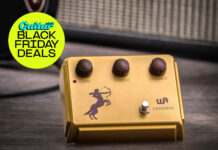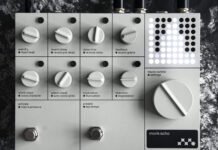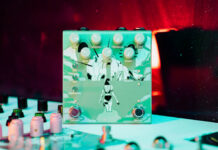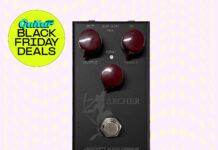
The history of Tech 21 and the SansAmp: how a hobbyist engineer changed guitar pedals forever
Back in the late 80s and early 90s, guitar players were faced with an uncomfortable dilemma. Digital and solid-state guitar technology was moving forward apace, but gigging players were still stuck between the inherent hassle of traditional valve amps, and somewhat sterile and uninspiring sound offered by newfangled digital options.
The popularity of Tom Schulz’s Rockman and the family of amps it spawned had proved a huge step forward in sounding good without needing to blow your head off, but the Rockman’s sound was still rather niche and didn’t really cater to the needs of players as the 80s turned into the 90s.
READ MORE: How the Rockman revolutionised guitar tone and changed recording forever
Guitarist Andrew Barta was very much aware of this – as a guitarist himself, he knew firsthand how fed up guitarists and bassists were with lugging around cumbersome and often temperamental amps all the time.
“In the 80s, tube amps ruled – and with good reason,” he explains. “But it’s time consuming to find their sweet spot, and they’re expensive to maintain.”
Even as solutions to making amps sound good at lower volumes emerged – such as H&K’s Red Box or Groove Tubes’ speaker emulators – they still required the presence of an amplifier to work, which didn’t exactly remove any real hassle from load ins at gigs or in the studio.
“It was also about the frustration factor of spending the majority of time – and money – in the studio getting the right sound and then having little time left over to actually record,” Barta reflects.
Frustrated then, he decided to take it upon himself to solve that problem: “It was a situation of necessity being the mother of invention,” he reflects. “I made it a personal mission to find a way to replicate the tones of tube amps and not have to deal with the headaches”.
The 1981 SansAmp Classic. Image: Press
From Hobby to Revolution
Crucially, aside from being a guitarist himself, Barta was also an electronics engineer. During his off-hours from working in music stores performing modifications, customizations, and repairs he used his formal electronics education and hands-on experience to begin designing something revolutionary.
Rather than the cumbersome and temperamental nature of a tube amp, or some lifeless digital recreation, Barta’s vision was to create an all-analogue guitar pedal circuit that could emulate the natural sound, behavior, and response of tube amplifiers.
Barta pitched his idea to some of the big hitters in the guitar pedal industry, but got shut down pretty quickly. “It was all negative!” he reflects. “They couldn’t get past their own tube amp snobbery to see the potential.”
Barta believed in the idea, and so did other guitarists and friends who tried his invention. At the urging of his friend Dale Krevens, Barta decided to set up a company to build and sell the product himself.
“I had no intention of becoming a manufacturer,” Barta admits.”But it was a blessing in disguise.”
Krevens’ advice would pay off – he’d go on to become the VP of the company that Barta would found. Tech 21 had arrived.
The SansAmp Classic 20th Anniversary. Image: Press
Sans Speakers, Plenty of Amp
Barta named his new product, succinctly and appropriately, the SansAmp – and it more than lived up to expectations. This was a rugged and reliable unit that recreated much of the tone, character and response of a tube amp, but it could fit onto a pedalboard, or even slot into the pocket of a gigbag.
Nowadays in this world of Helixes, Quad Cortexes, Milkman Amps and endless floor-based analogue and digital amp pedals, that might not seem like a big deal – but in the early 90s it was positively revolutionary.
Foreigner’s Mick Jones was an early adopter and evangelized its tone and efficiency through word-of-mouth. Eventually retail giant Sam Ash agreed to sell one on consignment, despite their perception that it was “just another distortion box” and were soon convinced of the potential of something that was far more than that.
Bulk manufacturing of the SansAmp began out of a back office in New York City. Tech 21 soon relocated to a facility in midtown Manhattan with double the space to accommodate the company’s growth and an expanding product line.
In truth, it wasn’t just the convenience factor that makes the SansAmp so appealing. The reason it remains a popular and beloved pedal to this day is because while it was trying to emulate the sound of amplifiers, it has a sound all of its own – one that many players still love and rely on over 30 years later.
Testing Classics in the 1990s. Image: Press
Analogue Spirit
Nowadays players gravitate to the idea of the SansAmp because of its analogue nature, but Barta reveals that it wasn’t any kind of purist streak that led him down that path – he simply found that digital technology was not mature enough to do the job at that time.
“Latency and resolution were major issues,” he explains. “Eight-bit converters weren’t suitable for quality sound processing and couldn’t deliver the warmth and responsiveness of analogue.”
The original SansAmp (now known as the Classic) offers a three way switch that models the sound of Marshall, Mesa/Boogie and Fender-style preamps, but the real magic lies in the eight DIP switches in the character section.
Long before Chase Bliss opened up a world of tweakability by adding banks of DIP switches to the outside of their pedals, Barta was using the small bank on the SansAmp to let you tweak things like midrange boost, brightness and even speaker micing simulation. It added a level of on the fly customisability that made the SansAmp even more versatile and useful for gigging and recording guitarists.
Interestingly, the DIP switches weren’t actually meant to be a part of the final product. Barta included them in the prototype, and after he settled on the settings, his intention was to remove them. However, Mick Jones advised him to keep them, as he felt they made the circuit even more unique – the rest is history!
Bassist Doug Wimbish on an ad for the SansAmp in 1991. Image: Press
Tube Tone Sans Tubes
Exactly how the SansAmp does what it does is a well kept trade secret. But it nails the sound, feel, and dynamics of a tube amp from preamp to power section. Onboard speaker simulation is crafted to replicate the even response of multiple microphones on a cabinet.
This eliminates the uneven frequency response of using only a single microphone. External impulse responses can be inserted after the pedal, which opens up tone options significantly.
The SansAmp product line has expanded quite a bit over the years to include the GT2 with simplified controls, rackmount and bass guitar versions, and the Character series, each model dedicated to emulating specific amps.
Tech 21 even incorporated the technology into a similarly influential tour-friendly multi-effects unit. The FlyRig series features options for electric and acoustic guitar, bass, and signature models – they’re still all analog.
As the SansAmp has become part of a much more crowded marketplace of pedal-based amp solutions – especially since the explosion of digital emulation since the turn of the Millennium – the focus has been on emphasising the unique sonic character of the SansAmp.
In no way has this been more exemplified than when Tech 21 partnered with Bomb Factory to create the PSA-1 plugin, bringing the sound of the SansAmp into the box. The plugin soon became so popular it was even bundled with Pro Tools.
The first SansAmp ad in 1991. Image: Press
Blueprint for the future
When the SansAmp first released in 1989 it showed the world how guitar technology was changing and revolutionised what direct recording could be for guitars. Even today, Barta feels analogue topology offers a response to playing articulation and dynamics that modern digital amp emulators haven’t completely nailed yet.
Three and a half decades later, it’s what keeps the SansAmp relevant to this day, and continues to drive Barta to evolve the product – he simply wants to keep making things he’d like to use.
“Pride and ethics,” Barta explains of his guiding principles. “It’s more important and rewarding for me to design what I believe in versus compromising just to make a profit. There’s no personal joy in being a copycat.”
Find out more at tech21nyc.com
The post The history of Tech 21 and the SansAmp: how a hobbyist engineer changed guitar pedals forever appeared first on Guitar.com | All Things Guitar.
Source: www.guitar-bass.net













